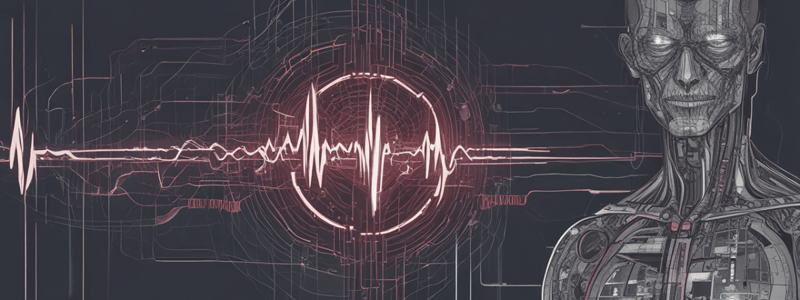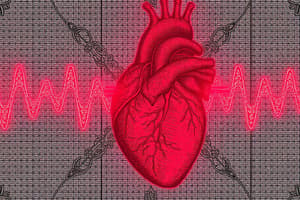Podcast
Questions and Answers
Which ECG feature is considered normal in young, healthy athletes?
Which ECG feature is considered normal in young, healthy athletes?
- Diffuse J point ST elevation
- Slowly curving ST segment with only an area J point can be found
- Merged ST segment and T wave
- Sharp J point ST segment and T wave that are well demarcated (correct)
What is the criteria for significant ST segment elevation in leads V2-V3?
What is the criteria for significant ST segment elevation in leads V2-V3?
- ≥0.15mV in women and ≥0.2mV in men ≥40yo
- ≥0.2mV in women and ≥0.25mV in men ≤40yo
- ≥0.15mV in women and ≥0.25mV in men ≤40yo (correct)
- ≥0.1mV in women and ≥0.15mV in men ≥40yo
What is the relationship between the P wave and QRS complex that indicates left atrial enlargement (LAE)?
What is the relationship between the P wave and QRS complex that indicates left atrial enlargement (LAE)?
- P wave > 0.25mV in lead II
- R wave in V5 or V6 >25mm
- R wave > S wave in V1
- P wave > 0.12s and bifid in lead II (correct)
Which ECG pattern indicates an inferior myocardial infarction?
Which ECG pattern indicates an inferior myocardial infarction?
What is the criteria for significant ST segment depression?
What is the criteria for significant ST segment depression?
What ECG pattern indicates right ventricular hypertrophy (RVH)?
What ECG pattern indicates right ventricular hypertrophy (RVH)?
What is the specific ECG feature that is characteristic of right atrial enlargement (RAE)?
What is the specific ECG feature that is characteristic of right atrial enlargement (RAE)?
In anterior myocardial infarction (MI), which ECG leads typically show significant abnormalities?
In anterior myocardial infarction (MI), which ECG leads typically show significant abnormalities?
What does a prolonged and bifid P wave in lead II suggest on an ECG?
What does a prolonged and bifid P wave in lead II suggest on an ECG?
Which condition would most likely present with a pattern of ST segment elevation in leads I, aVL, V5-V6 on an ECG?
Which condition would most likely present with a pattern of ST segment elevation in leads I, aVL, V5-V6 on an ECG?
What characteristic ECG finding is associated with patterns suggestive of left ventricular hypertrophy (LVH)?
What characteristic ECG finding is associated with patterns suggestive of left ventricular hypertrophy (LVH)?
Which leads typically show significant ST elevation in the case of an inferior myocardial infarction (MI) on an ECG?
Which leads typically show significant ST elevation in the case of an inferior myocardial infarction (MI) on an ECG?
Flashcards are hidden until you start studying




